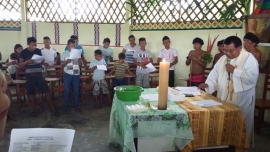“The missionary concept today goes further in the sense that mission has no boundaries. But these Provinces are considered missionary because they have a very specific work with the indigenous,” explains Fr Reginaldo Cordeiro, SDB, Vicar and Delegate for Missionary Animation of BMA. “Our Province was born with the first house in São Gabriel da Cachoeira in 1915 and developed from the periphery, from the indigenous populations to the urban centers. Today, with 105 years of presence, we have made much progress in knowledge and evangelization. We see that indigenous and non-indigenous peoples need each other, they support each other, and this meeting of cultures is very beautiful and important,” adds the Salesian.
The State of Amazonas is geographically very large. In 1914 the Holy See entrusted the Apostolic Prefecture of Rio Negro to the Salesians of Don Bosco (SDB) and the first Salesians arrived in the region the following year, establishing the headquarters of their new mission in São Gabriel da Cachoeira, about 850 km from Manaus. They soon spread throughout the region, opening oratories, schools, youth centers and parishes, without neglecting the missionary presence among the indigenous.
Today there are five Salesian missionary presences in the Rio Negro region and its tributaries. In São Gabriel da Cachoeira, Santa Isabel and Iauaretê, the mission is shared between SDB and FMA and involves 23 different indigenous ethnic groups, with parish, oratory, catechesis, vocational training courses and visits to different communities. While in Maturacá and Marauiá the Salesians work exclusively with the Yanomami; in Maturacá, through a parish and the spiritual assistance offered in periodic visits; in Marauiá, with a less structured presence.
“Missionary work with indigenous peoples consists above all in a quality religious presence, in being with people, who have their own culture, their own customs and their own religion. It is an experience of encounter with the other and, starting from this, of service, development and evangelizing action,” explains the Salesian. According to him, one of the great challenges of the Salesian mission today is the encounter between the Salesian charism and the spirituality and way of being of the indigenous people. “The great challenge is this meeting of values to form an indigenous Church, that is, one that emerges from the meeting of two cultures. No culture must overlap, but rather must intertwine. The Synod of the Amazon has come to reinforce this concept, that the Church express its values by taking steps towards inculturation.”


